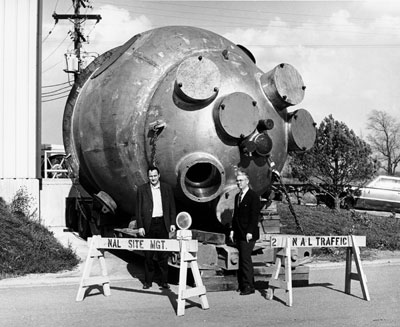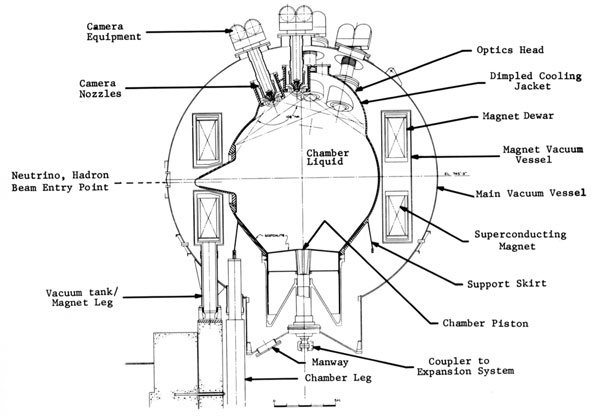University of Chicago Synchrocyclotron to Find New Home at NAL Neutrino Lab
To date [September 1971], 155 proposals have been received from the high energy physics community to conduct experiments on NAL's accelerator system. Of these, 52 have been approved by the program advisory committee.
One approved research effort is designated as Experiment No. 98. It will be a complex endeavor involving, literally, some of the heaviest equipment on the NAL site. Scientists from Oxford University, Harvard, the University of Chicago and NAL will be involved, as well as distinguished physicists from the United States and Great Britain.
So that Experiment No. 98 and others can be conducted here, the 2,500-ton magnet from the University of Chicago synchrocyclotron, built nearly five decades ago, is being moved nearly 45 miles from the University campus to NAL. Sometime this fall, the heavy magnet will be placed in the muon experimental area of the NAL Neutrino Laboratory. A special building will be constructed to house the magnet near the "Wonder Building," not far from Wilson and McChesney roads.
Experiment No. 98 is scheduled to begin July 1, 1972. However, it is expected that the magnet, and supporting facilities, will be in place by late next Spring [actually, Spring 1973].
"We will be very happy to have this valuable piece of equipment available at NAL since it would have cost much money and involve a great deal of time to duplicate it."
With those words, Taiji Yamanouchi, physicist on the NAL Neutrino Laboratory staff, greeted the news that the University of Chicago's synchrocyclotron, was being moved to NAL.
A main part of the early model particle accelerator will be used as an analyzing magnet to study the structure of the proton using muons as a probe.
It will be a heavy moving job from the synchrocyclotron's home near 57th Street and Ellis Avenue in Chicago's Hyde Park district to the NAL site, a distance of about 45 miles.
The Experiment No. 98 team will study the scattering of high-energy muons from targets made of liquid hydrogen and other materials. The experiments will utilize the proton beam from the NAL accelerator.
Dismantling of the synchrocyclotron began July 12 under the direction of Leroy Schwarcz, the chief mechanical engineer who built it in 1950-52. Schwarcz is now [was in 1971] a senior staff member at Stanford Linear Accelerator Center (SLAC).
S. Courtenay Wright, Professor, Department of Physics, the Enrico Fermi Institute, and the College of the University of Chicago, helped make plans for moving the magnet to NAL.
Schwarcz is now [September 1971] directing the removal of 3,700 tons of concrete shielding that protected staff and researchers from radioactivity from the synchrocyclotron when it was in operation. The concrete rests in two layers of concrete beams that weigh 80 tons each, covering most of the pit containing the synchrocyclotron.
It is expected that the synchrocyclotron will be totally dismantled at the University about October 15. Shipping of the components of the magnet are scheduled to start that day. It will require 22 truckloads, with one 90-ton segment magnet on each truck, to accomplish the transfer, according to Robert G. Sachs, Professor in the Department of Physics and Professor and Director of the Fermi Institute
Sachs noted that some of the synchrocyclotron's greatest work was being done right up until the last minute of its operation, 8 a.m., July 12, 1971 on an experiment involving muonium by Valentine L. Telegdi, Professor in the Department of Physics and the Institute, and his collaborators. Muonium is a man-made atom of a fleeting life consisting of a positive mu meson and an electron. Telegdi's experiment involved ultra-high precision measurements which give new information on the fundamental constants of physics.
In the early 1950's, the synchrocyclotron's 450 MeV (450 million electron volt) proton beam was one of the world's prime sources of mu and pi mesons (muons and plons)" opening up a whole new field of science-particle physics.
Since then, a bewildering variety of "new" subatomic particles has been discovered in research using particle accelerators.
The purpose of the experiment at NAL is to investigate the basic structure of the proton, one of the basic building blocks




